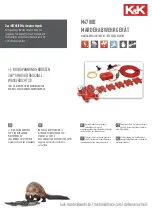
page
2
1
General instructions
2
Index
3
0 - Handbook layout
4
1 - Studio 12 Scan Control console layout
4
1.1 - Main features
4
1.2 - Technical specifications
5
1.3 - Studio 12 Scan Control’s sections
5
1.3.1 - Manual Presets
5
1.3.2 - Registers
5
1.3.3 - Light Chase Controls
6
1.3.4 - Masters
6
1.3.5 - DMX Unit Controls
7
1.4 - Studio 12 connectors
7
1.4.1 - DMX 512
7
1.4.2 - Up-Down pedal
7
1.4.3 - SMPTE
7
1.4.4 - Midi
7
1.4.5 - RS-232
7
1.4.6 - Audio In
8
1.4.7 - Disconnecting the power supply
8
2 - Console maintenance
8
2.1 - Access to internal components
8
2.2 - Cleaning and periodical checks
9
3 - Studio 12 Scan Control operating modes
10
4 - Manual Presets section
10
4.1 - Manual Presets in double preset mode
10
4.1.1 - Go function
11
4.1.2 - Solo function
11
4.1.3 - Link function
11
4.2 - Manual Presets in single preset mode
12
4.1.1 - Go function
12
4.1.2 - Solo function
12
4.1.3 - Link function
13
5 - Registers section
13
5.1 - Memory pages
13
5.2 - Register operating modes
14
5.3 - Storing a scene
14
5.4 - Modify a stored scene
14
5.5 - Copying a stored scene to another scene
15
6 - Light Chase Controls section
16
6.1 - Chase running
16
6.2 - Creating and modifying chases
17
7 - DMX Unit Controls section
18
7.1 - Direct mode use
19
7.1.1 - Program elements
19
7.2 - Groups of units
20
7.3 - Movement effects
20
7.4 - Use in Reg mode
20
7.5 - The Utilities
21
7.5.1 - Remote lamp ignition
21
7.5.2 - Remote fixture reset
21
7.5.3 - Operating areas
22
7.6 - Creating a program
22
7.6.1 - Copying a scene
23
7.6.2 - Copying a program
23
7.6.3 - Adding a Program to a Memory Register
24
8 - Setup functions
24
8.1 - Addressing light channels
24
8.1.1 - Equalization curves
24
8.2 - Addressing the fixtures
25
8.3 - Changing the language used
25
8.4 - Available memory
26
8.5 - Built-in memory
26
8.5.1 - Creationg a new unit
26
8.5.1.1 - DMX channel total
26
8.5.1.2 - LCD effect labels
27
8.5.1.3 - Internal addressing
28
8.5.1.4 - Standby values
28
8.5.1.5 - Type of effect
29
8.5.1.6 - Mirror/Head
29
8.5.1.7 - Slope Speed
30
8.5.1.8 - Unit name
30
8.5.1.9 - Remote and lamp reset values
31
8.5.1.10 - Dip-switch configuration
32
8.5.1.11 - Beam search values
32
8.5.1.12 - Type of control
34
8.5.2 - Error messages
35
8.5.3 - Modifying a unit in the library
35
8.5.4 - Deleting a unit from the library
36
9 - Using the connectors
36
9.1 - Pedal
36
9.2 - SMPTE socket
36
9.3 - Midi connectors
37
9.3.1 - Midi In - Note On
37
9.3.2 - Midi In - Note Off
37
9.3.3 - Midi In - Program Change
38
9.3.4 - Midi In - All Channels Off
38
9.3.5 - Midi In - Bank Select
38
9.3.6 - Midi Out - Program Change
38
9.3.7 - Midi Out - Bank Select
38
9.4 - RS-232 connections
38
9.4.1 - RS-232 - Channel On (01h)
38
9.4.2 - RS-232 - Channel Off (A2h)
39
9.4.3 - RS-232 - All Off (A3h)
39
9.4.4 - RS-232 - Register Change (A0h)
39
9.4.5 - RS-232 - Page Change (A4h)
39
9.4.6 - RS-232 - Device Select (A6h)
40
10 - Using ‘Event Recording’
40
10.1 - ‘Event Recording’ operating modes
40
10.2 - Creating a track
41
10.3 - Replaying a track
42
11 - Advanced use of the Studio 12 Scan Control
42
11.1 - Multiple units
45
11.2 - Multiple scanner units
46
11.3 - Using the colourchangers in pseudo-random mode
47
12 - Quick Reference
50
12.1 - Tree structure diagram of Setup functions
51
13 - Practical users guide
Index




































